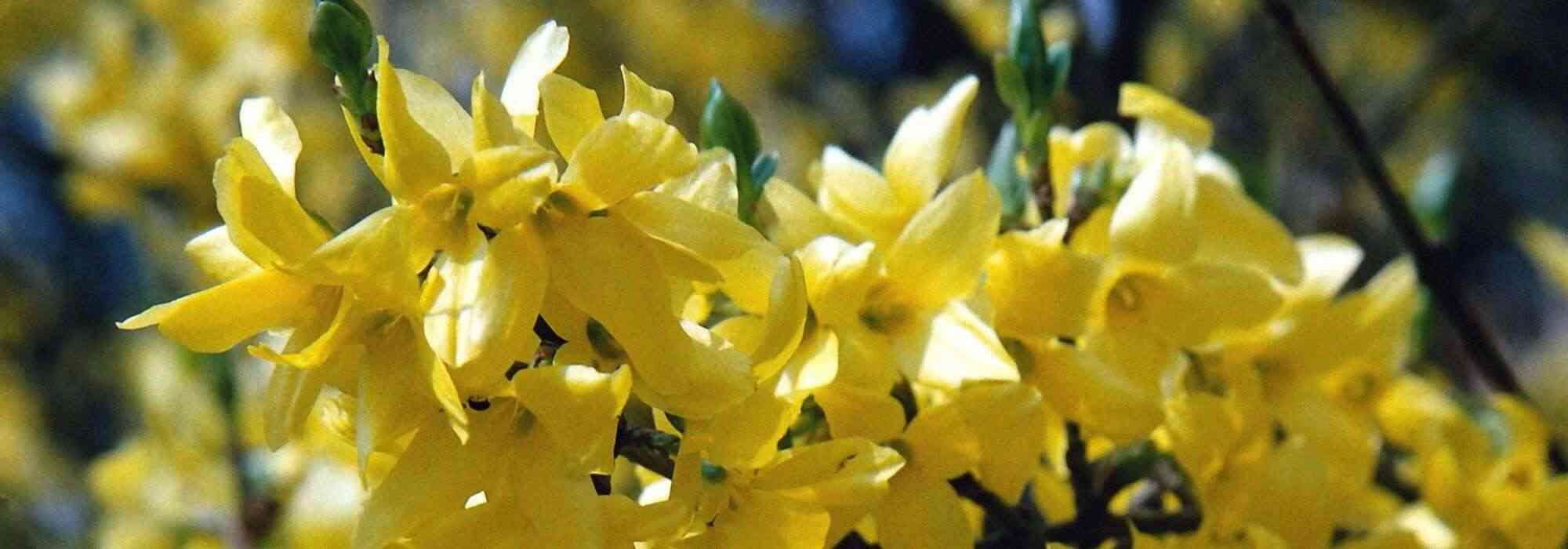
Forsythia: 7 ideas for garden combinations
beautiful scenes, in every season
Summary
Forsythia is one of spring’s emblematic bushes. Valued for its yellow flowering that brightens the first fine days of spring, it is sometimes criticised for being somewhat commonplace. However, there are multiple ways to showcase it by choosing suitable companion plants. Ideal in a hedge, it can also find a place in a bed of bushes or perennials, as well as in a rockery. You can also use it as a support for climbing plants, and play with its foliage, soft green or variegated, reddening in autumn in some varieties. Finally, dare to be original with a white-flowering Forsythia!
Discover my 7 pairing ideas to complement or extend interest in this very accommodating bush!
Colourful spring border
All forsythias pair wonderfully with early-flowering bulbs, such as Crocus, Hyacinths, Tulips or Narcissi. The contrast of their bright yellow is particularly striking against a tapetum of blue or lavender flowers. This can be enhanced with yellow accents echoing the hue of the bush, or brightened by white-flowering bulbs. Try, for example, the variety ‘Mikador’, a compact form, on a tapetum of Anemone blanda ‘Blue Shade’ or Crocus ‘Firefly’. A few clumps of Narcissus ‘Dutch Master’ or ‘Barrett Browning’ and spring wakes up with cheer!
Among perennials, try Hellebores, many of which are still in flower at this time, or Bergenias. The airy effect of a few clumps of Brunnera (Siberian bugloss) brings a touch of lightness to the whole, unless you prefer the spreading habit of Lungworts. Foliage of these perennials is also very decorative and extends the display once flowering has finished.
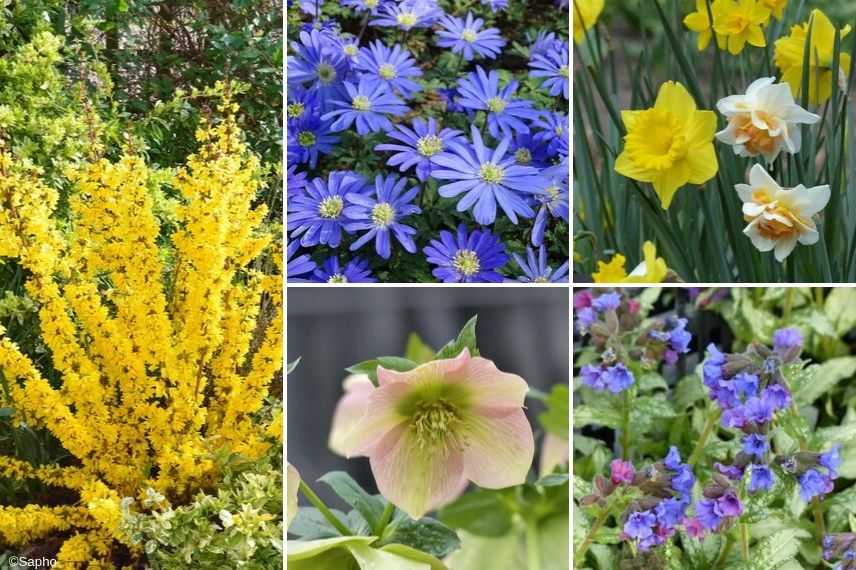
An example of a spring pairing: Forsythia ‘Mikador’, Anemone blanda ‘Blue Shades’, Narcissus ‘Dutch Master’ and ‘Replete’, Oriental hellebore ‘Apricot’ and Pulmonaria ‘Diane Clare’
You may also read
Forsythia : plant, prune and maintainFoliage and flower combinations in a bed of bushes
Beds of bushes create beautiful groupings in a garden, for example to mark a corner. Pair the bright green leaves of a large Forsythia ‘Spectabilis’ with dark foliage, such as that of Physocarpus ‘All Black’ or Black elder ‘Black Lace’. Berberis ‘Bagatelle’, with very dark purple foliage and modest size, is used in the foreground to dress the base of Forsythia.
The bright foliage, green variegated with yellow, of Forsythia ‘Golden Times’ contrasts beautifully with the purple-tinged foliage of Cotinus ‘Royal Purple’. To accentuate foliage effects, add the coppery-orange note of young leaves from a compact-habit Spirea ‘Goldflame’. Also very dense, Photinia ‘Chico’ displays evergreen foliage with red to coppery tones, attractive all year round. Grey and silvery tones help tie other colours together while highlighting them. Turn to the evergreen foliage of Elaeagnus ebbingei or Germander ‘Azureum’. Deciduous, Caryopteris ‘Sterling Silver’ also offers autumn flowering whose blue creates a fine contrast with variegated-leaf forsythias.
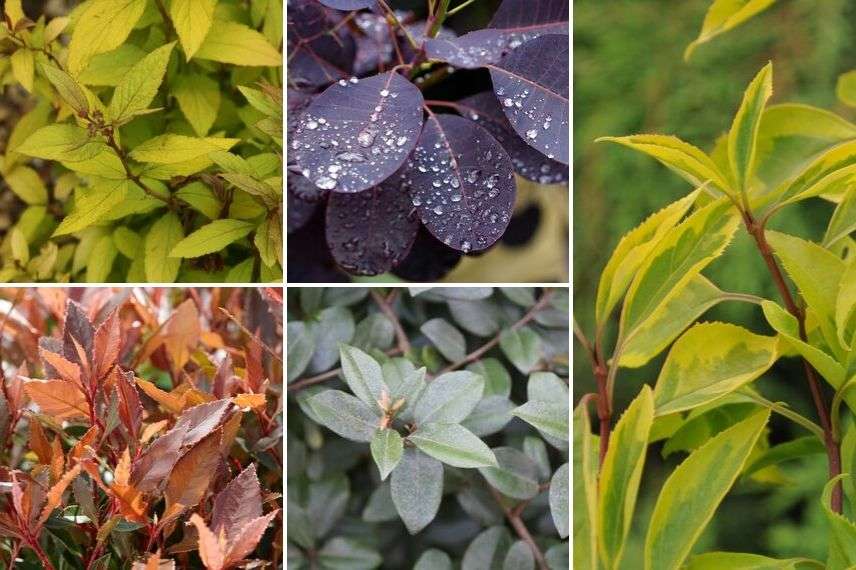
An example of pairing with other bushes: Forsythia ‘Golden Times’, Spirea japonica ‘Goldflame’, Cotinus ‘Royal Purple’, Photinia ‘Chico’ and Elaeagnus ebbingei
Flowering also enables lovely combinations. Many bushes flower at the same time as forsythias; choices include Pieris, flowering currants, early broom species or Japanese quince.
Discover other Forsythia
View All →Available in 3 sizes
Available in 3 sizes
Available in 2 sizes
Available in 1 sizes
Available in 3 sizes
Available in 1 sizes
Available in 1 sizes
Available in 1 sizes
Available in 3 sizes
Available in 2 sizes
Varied and flowering hedge
Forsythias are remarkable hedge bushes, but rather than using them in a clipped, monotonous hedge, let them adopt a freer habit by mixing them with other species. This creates a hedge that evolves through the seasons and brings colour and fragrance for many months. In any case, always include about one third bushes with evergreen foliage to keep interest in your hedge, even in winter.
Choose bushes that flower at the same time as Forsythias, such as Spiraea thunbergii, Japanese quince, whose flowers in shades of white, red, pink and even fawn also appear on the naked wood, Chinese flowering almonds such as Prunus triloba with very double pink pom-poms, or Chinese loropetalums, whose beautiful evergreen, purple-coloured foliage is set off by ruffled flowers.
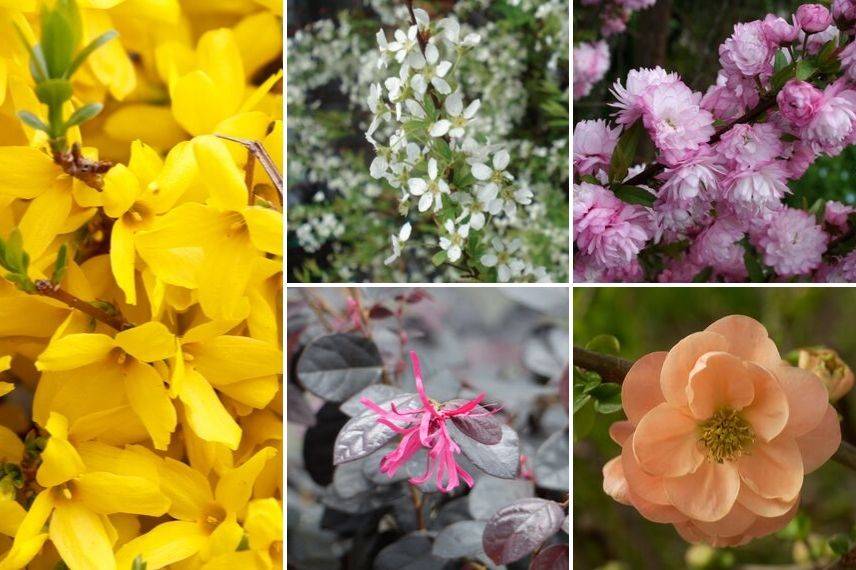
An example of a hedge combination: Forsythia, Spiraea thunbergii, Prunus triloba, Loropetalum chinense ‘Pipa’s Red’ and Chaenomeles speciosa ‘Cameo’ (@Minier)
To extend decorative interest of your hedge, select bushes with later flowering. Options are plentiful: Deutzias, Abelias, Viburnums (some are highly fragrant), Weigelas, Mexican orange blossom (Choisya), Lilacs or Philadelphus (mock orange).
Think about foliage of Cotinus, Physocarpus, Elaeagnus, or that of variegated dogwoods (whose coloured wood keeps company with your Forsythias in the off-season)
Try to intersperse your Forsythia so it is not overwhelmed by other foliage of the same green. Vary things by planting one variety with plain foliage and another variegated one such as ‘Kumsun‘. Choose a limited number of species and repeat the pattern randomly, otherwise the result may look a little artificial. Staggered planting even allows you to place the largest Forsythias at the back and more compact ones, such as ‘Mêlée d’Or‘, between two other bushes in the foreground.
You may also read
Abeliophyllum: planting, growing and careSunny rockery
Forsythias of modest size and with spreading habit, such as ‘Marée d’Or‘ and ‘Minigold‘, are well suited to use in rockeries. Accompany their spring flowering with small bulbs such as Crocus, reticulate Iris, Muscari or small Allium triquetrum, favouring blue, lavender or white tones. Low perennials or small shrubs then take over to bring colour during the growing season. Phlox (divaricata or subulata in particular), Erigerons and Sedums, as well as Phlomis, Cistus, Lavenders and Santolinas with grey foliage, together with small ornamental grasses, accompany Forsythia once its flowering has finished. Finally, some succulents such as Houseleeks can add a touch of the exotic. Use them in tapetum at base of your bush, for example, then, depending on size of your rockery, add small additional touches here and there.
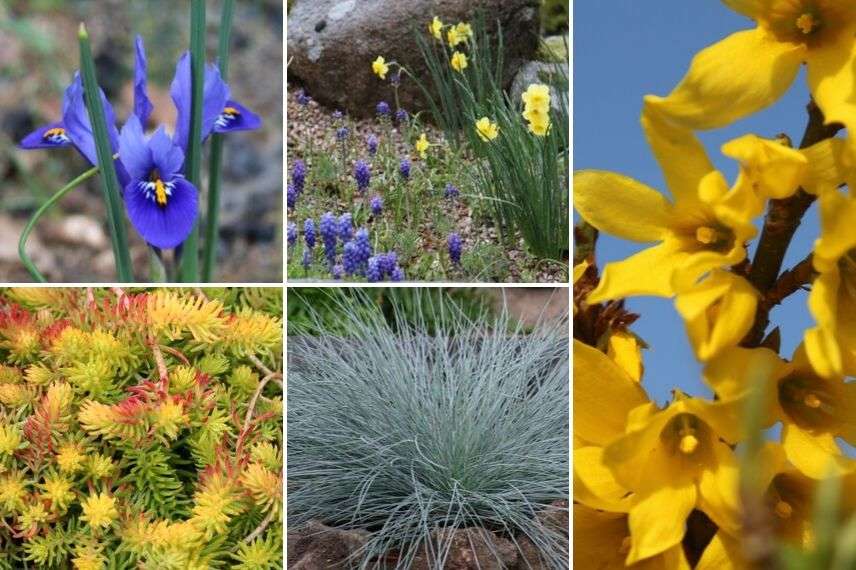
An example of a rockery combination: Forsythia ‘Marée d’Or’, small yellow daffodils (such as ‘Baby Moon’ for example) and Muscari, Festuca ‘Intense Blue’ and Sedum reflexum ‘Angelina’
Autumn scene in warm hues
Forsythias are kings of spring, but some also add warmer colours in late season. Without upstaging autumn’s stars, attractive varieties such as ‘Citrus Swizzle‘ and ‘Mêlée d’Or‘ can complete a late-season scene. These two forsythias, about 1 m in every direction, develop lovely purplish to violet hues.
Place their silhouettes against larger specimens that blaze as days shorten, such as Amelanchier ‘Lamarckii’, Hornbeam ‘Orange Retz’, or Persian ironwood (suitable for larger gardens). Winged euonymus, some viburnums and Japanese maples (in light, well-drained soil) are among other classics. Add grasses whose golden spikes erupt like sheaves dancing in the wind. Some, such as Miscanthus ‘Malepartus’ or ‘Ghana’, have foliage that turns shades of purple, gold and brown for a striking effect. Plant clumps of Pennisetum ‘Little Bunny’ in front of your forsythia, and complete with flowering of late perennials such as asters, Japanese anemones, persicarias, sedums or hardy geraniums. At base of your composition, clumps of bulbs may emerge, waiting for autumn to show their best. This is, for example, the case with colchicums.
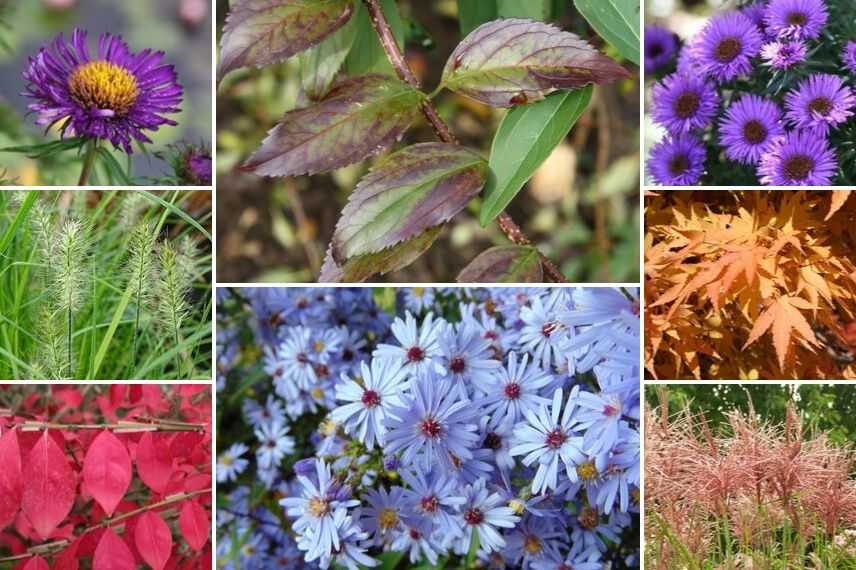
An example of an autumnal combination: Forsythia (especially ‘Citrus Swizzle’ or ‘Marée d’Or’), Aster novae-angliae ‘Violetta’, Pennisetum alopecuroides ‘Little Bunny’, Euonymus alatus, Aster cordifolius ‘Little Carlow’, Aster novae-angliae ‘Purple Dome’, Acer palmatum ‘Sangokaku’ and Miscanthus sinensis ‘Malepartus’
A living support for climbing plants
Bushes make ideal supports for climbing plants, and the Forsythias are no exception. Among lianas to pair with them, opt without hesitation for Clematis, taking care to select varieties of suitable size. Those with winter flowering, such as the lovely Clematis cirrhosa, flower before the bush and grace its bare wood with elegance. Spring-flowering clematis allow beautiful combinations, when the corollas of climber and bush mingle. For example, pair the blue-violet flowers of Clematis alpina ‘Blue Dancer’ with the golden-yellow blooms of Forsythia ‘Week-end’. Another advantage is that clematis in this group are pruned at same time as the bush. To extend decorative interest, summer-flowering clematis are ideal. Their flowers open once those of the bush have faded. With large single flowers such as ‘Jackmanii’, bicoloured forms like ‘Souvenir du Capitaine Thuilleaux’ or scented types among the Clematis integrifolia, choice is very wide. To avoid mistakes at pruning time, discover in our article how to prune the different clematis.
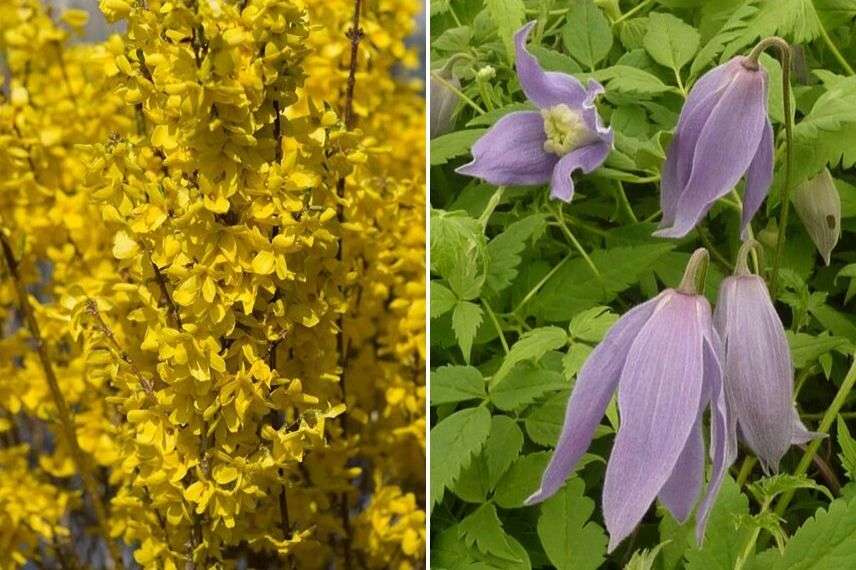
An example of pairing: Forsythia ‘Week-End’ and Clematis alpina ‘Blue Dancer’
Among other lianas to plant in a Forsythia, annual climbing plants with rapid growth allow you to create a charming display for the whole season. Easy to sow and to grow, their growth habit lets you prune your bush without risking compromise to its flowering. Discover my selection of the 10 best annual climbing plants to train up your Forsythia.
Forsythia in a wedding dress
Although it has nothing botanically in common with previous ones, Abeliophyllum distichum is commonly called white Forsythia of Korea. Its flowers indeed resemble those of a Forsythia, but they are either white or more pinkish for ‘Roseum‘ variety. As easy to grow as its ‘cousins’, it also offers a pleasant almond scent in late winter or early spring. About 1.50m high and as wide, it brings originality to a low hedge or a bush border. For simultaneous flowering, plant it with true Forsythias of similar dimensions, such as variety ‘Golden Times’, with variegated foliage, Japanese quince, early broom ‘Albus’ or Thunberg spirea, both also white-flowering, or Prunus triloba ‘Multiplex’, with fresh pink pom-poms. Don’t forget to intersperse evergreen bushes such as some Abelias, Ceanothus ‘Trewithen Blue’ (in mild climate), Mexican orange blossom with citrus scent, oleasters that perfume in autumn or Photinias with changing foliage. Bet on 4 to 6 different essential oils and repeat sequence in slightly random order.
In a border, set it against a larger bush that turns yellow in autumn, such as a Cornus sanguinea ‘Winter Beauty’ or a dwarf Ginkgo ‘Mariken’. Its purple tones then stand out against neighbours’ foliage. Enhance effect by adding pink of an Euonymus alatus or purplish-orange of an Euonymus planipes. Also play contrasts with leaf shapes using those of sumacs or smoke trees (which also reward you with superb spring and summer flowering). Finish scene with punctuations of grasses and perennials with late flowering for an unforgettable late-season tableau!
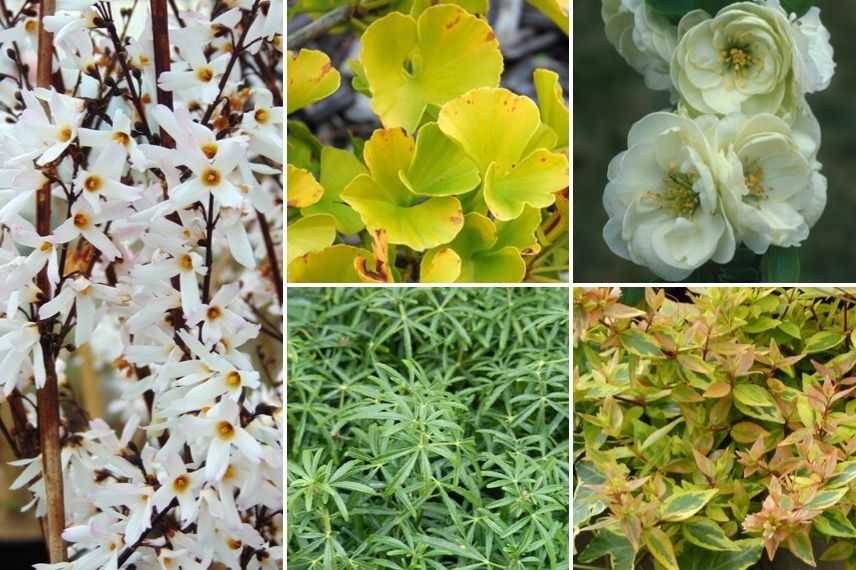
An example of association: Abeliophyllum distichum, Ginkgo biloba ‘Mariken’, Chaenomeles speciosa ‘Kinshiden’, Choisya ‘White Dazzler’ and Abelia grandiflora ‘Kaleidoscope’
- Subscribe!
- Contents
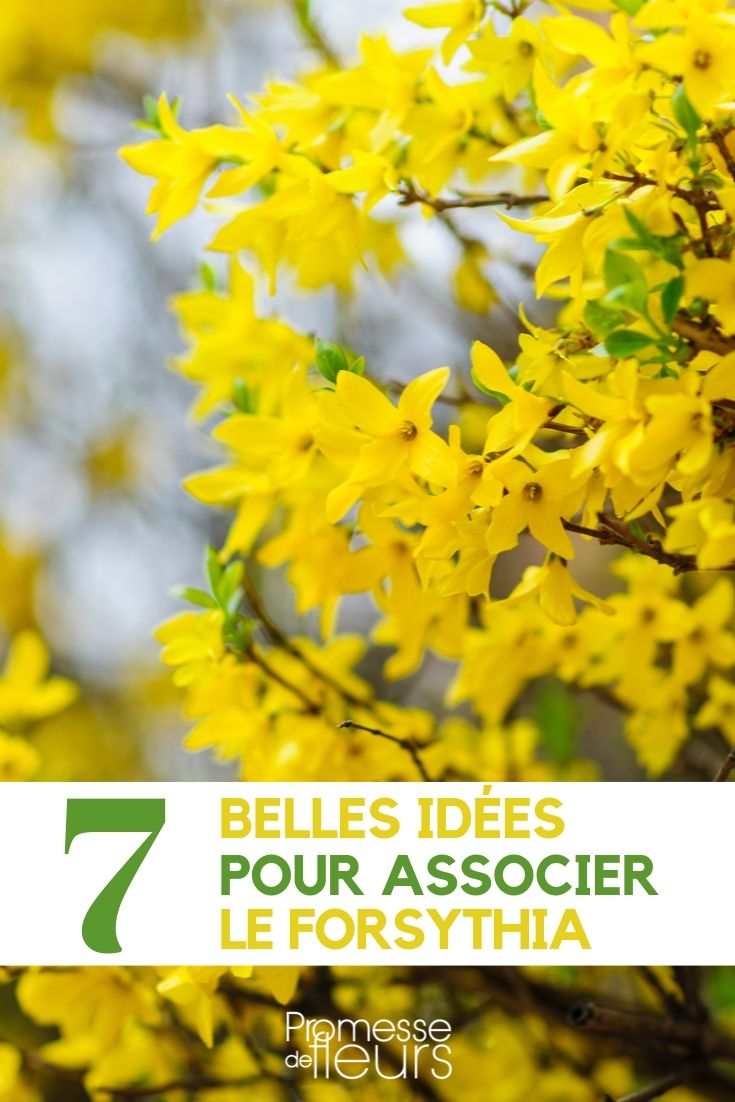

































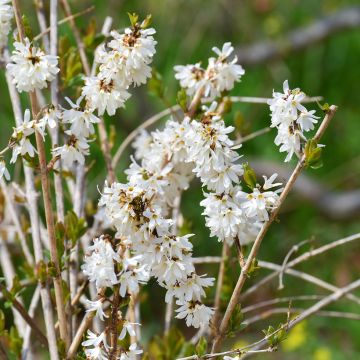
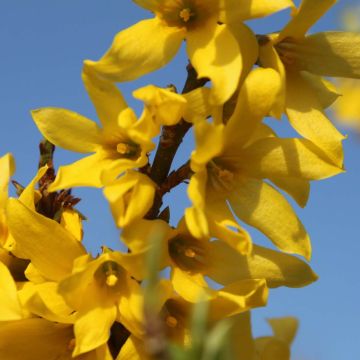

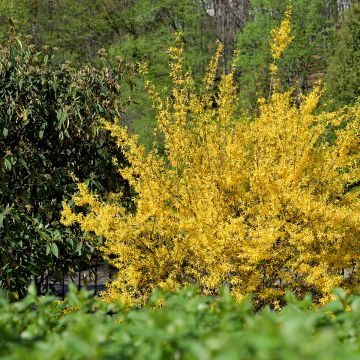
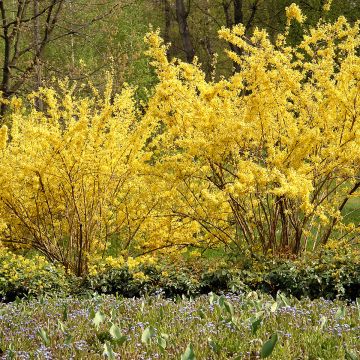
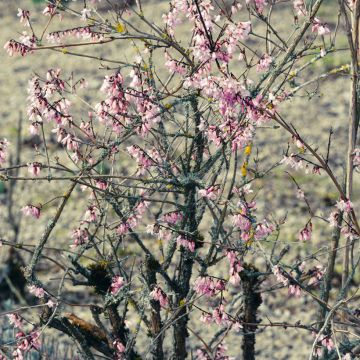

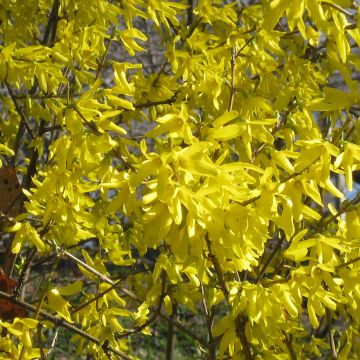
Feedbacks